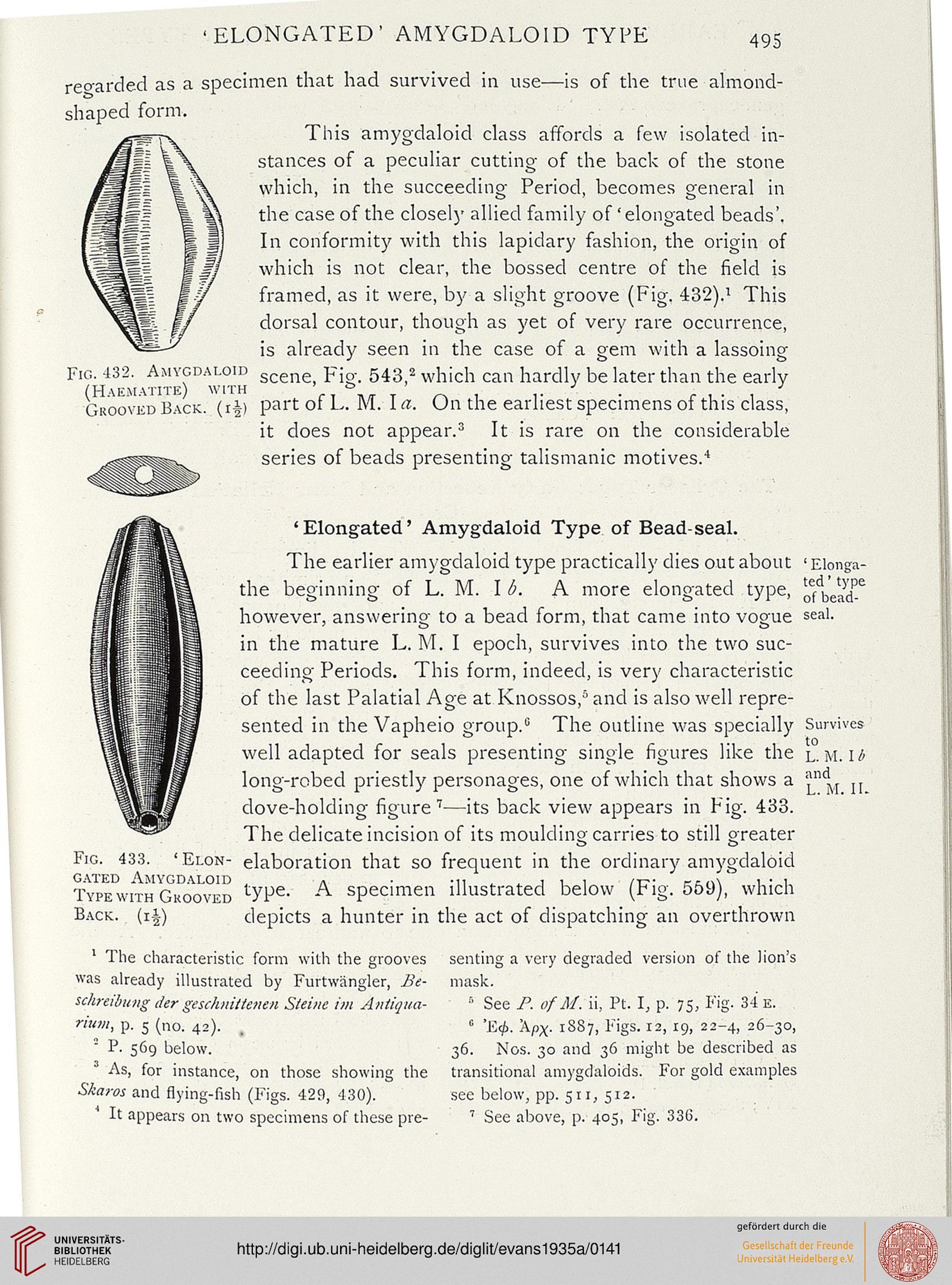'ELONGATED' AMYGDALOID TYPE
49S
regarded as a specimen that had survived in use—is of the true almond-
shaped form.
This amygdaloid class affords a few isolated in-
stances of a peculiar cutting of the back of the stone
which, in the succeeding Period, becomes general in
the case of the closely allied family of' elongated beads'.
In conformity with this lapidary fashion, the origin of
which is not clear, the bossed centre of the field is
framed, as it were, by a slight groove (Fig. 432).* This
dorsal contour, though as yet of very rare occurrence,
is already seen in the case of a gem with a lassoing
scene, Fig. 543,2 which can hardly be later than the early
part of L. M. I a. On the earliest specimens of this class,
it does not appear.3 It is rare on the considerable
series of beads presenting talismanic motives.1
Fig. 432. Amygdaloid
(Haematite) with
Grooved Back. (iJ)
'Elongated' Amygdaloid Type of Bead-seal.
The earlier amygdaloid type practically dies out about
the beginning of L. M. 16. A more elongated type,
however, answering to a bead form, that came into vogue
in the mature L. M. I epoch, survives into the two suc-
ceeding Periods. This form, indeed, is very characteristic
of the last Palatial Age at Knossos,5 and is also well repre-
sented in the Vapheio group.0 The outline was specially
well adapted for seals presenting single figures like the
long-robed priestly personages, one of which that shows a
dove-holding figure7—its back view appears in Pig. 433.
The delicate incision of its moulding carries to still greater
Fig. 433. 'Elon- elaboration that so frequent in the ordinary amygdaloid
Type with Grooved tvPe- A. specimen illustrated below (Fig. 559), which
Back. (iJ) depicts a hunter in the act of dispatching an overthrown
1 The characteristic form with the grooves
was already illustrated by Furtwangler, Be-
schreibung der geschnitienen Siei/ie hn Antiqua-
rium, p. 5 (no. 42).
" P. 569 below.
As, for instance, on those showing the
Skaros and flying-fish (Figs. 429, 430).
It appears on two specimens of these pre-
' Elonga-
ted ' type
of bead-
seal.
L. M. I b
and
L. M. II.
; a very degraded version of the lion's
, Fi:
seating
mask.
■ See P. of M. ii, Pt. I, p. 75, Fig. 34 e.
,; 'E<j>. 'Apx- 1887, Figs. 12, 19, 22-4, 26-30,
36. Nos. 30 and 36 might be described as
transitional amygdaloids. For gold examples
see below, pp. 511, 512.
7 See above, p. 405, Fig. 336.
49S
regarded as a specimen that had survived in use—is of the true almond-
shaped form.
This amygdaloid class affords a few isolated in-
stances of a peculiar cutting of the back of the stone
which, in the succeeding Period, becomes general in
the case of the closely allied family of' elongated beads'.
In conformity with this lapidary fashion, the origin of
which is not clear, the bossed centre of the field is
framed, as it were, by a slight groove (Fig. 432).* This
dorsal contour, though as yet of very rare occurrence,
is already seen in the case of a gem with a lassoing
scene, Fig. 543,2 which can hardly be later than the early
part of L. M. I a. On the earliest specimens of this class,
it does not appear.3 It is rare on the considerable
series of beads presenting talismanic motives.1
Fig. 432. Amygdaloid
(Haematite) with
Grooved Back. (iJ)
'Elongated' Amygdaloid Type of Bead-seal.
The earlier amygdaloid type practically dies out about
the beginning of L. M. 16. A more elongated type,
however, answering to a bead form, that came into vogue
in the mature L. M. I epoch, survives into the two suc-
ceeding Periods. This form, indeed, is very characteristic
of the last Palatial Age at Knossos,5 and is also well repre-
sented in the Vapheio group.0 The outline was specially
well adapted for seals presenting single figures like the
long-robed priestly personages, one of which that shows a
dove-holding figure7—its back view appears in Pig. 433.
The delicate incision of its moulding carries to still greater
Fig. 433. 'Elon- elaboration that so frequent in the ordinary amygdaloid
Type with Grooved tvPe- A. specimen illustrated below (Fig. 559), which
Back. (iJ) depicts a hunter in the act of dispatching an overthrown
1 The characteristic form with the grooves
was already illustrated by Furtwangler, Be-
schreibung der geschnitienen Siei/ie hn Antiqua-
rium, p. 5 (no. 42).
" P. 569 below.
As, for instance, on those showing the
Skaros and flying-fish (Figs. 429, 430).
It appears on two specimens of these pre-
' Elonga-
ted ' type
of bead-
seal.
L. M. I b
and
L. M. II.
; a very degraded version of the lion's
, Fi:
seating
mask.
■ See P. of M. ii, Pt. I, p. 75, Fig. 34 e.
,; 'E<j>. 'Apx- 1887, Figs. 12, 19, 22-4, 26-30,
36. Nos. 30 and 36 might be described as
transitional amygdaloids. For gold examples
see below, pp. 511, 512.
7 See above, p. 405, Fig. 336.





